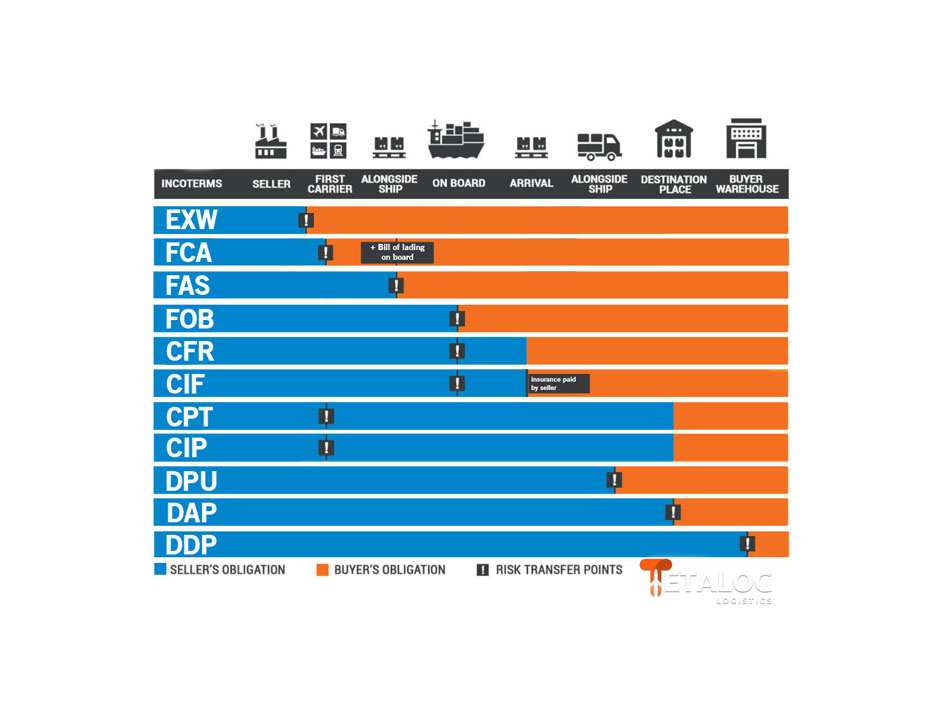
Incoterms are standard trade rules used in international commerce that define the responsibilities of the parties. The term “incoterms” is an abbreviation of “International Commercial Terms.” Incoterms consist of a series of terms covering details such as the place of delivery, responsibility for transfer risks, freight, customs duties, and other costs. These terms are used in export and import transactions to clarify the rights and obligations of the parties and to help resolve commercial disputes. They are determined by the International Chamber of Commerce (ICC) and are updated with revisions.
What are Incoterms?
Incoterms are a standardized set of terms that specify the responsibilities and risks of the parties regarding the transportation, insurance, customs procedures, and other logistics details of goods. These terms cover the most common delivery methods used in international trade, and each term specifies not only the responsibilities of the parties but also freight, insurance, customs duties, and other costs.
They are generally used in export and import transactions and help resolve commercial disputes between parties. Additionally, they are used by transportation, customs, and insurance companies.
They play a very important role because they provide a standard for determining the contract and delivery conditions between parties in international trade. This helps reduce risks during delivery and prevents commercial disputes.

Incoterms Rules
Incoterms, or International Commercial Terms, are a series of abbreviations that standardize the delivery conditions used in buying and selling goods. These abbreviations specify at which stages the goods will be delivered between the seller and the buyer.
Incoterms are standard delivery methods and rules used in international trade. The term “Incoterms” is an abbreviation of “International Commercial Terms.” These terms define the rights and responsibilities arising from the sale of goods. Incoterms specify the responsibilities of the seller and buyer and determine which party bears the costs during delivery. They also cover issues such as which party will prepare customs declarations, insurance, transportation documents, and other related documents.
Incoterms rules relate to the transfer of risk and ownership of goods at the moment the seller completes delivery. Incoterms are accepted as standardized delivery methods that specify the responsibilities of the seller and buyer and are applied in international trade.
There are 11 different rules of Incoterms 2020, which can be listed as follows:
- EXW (Ex Works): Delivery method where the seller is responsible for making the goods ready at the place of delivery.
- FCA (Free Carrier): Delivery method where the seller is responsible for delivering the goods to a specified carrier.
- CPT (Carriage Paid To): Delivery method where the seller is responsible for transporting the goods to a specified point and paying transportation costs.
- CIP (Carriage and Insurance Paid To): Delivery method where the seller is responsible for transporting the goods to a specified point, paying transportation costs, and arranging insurance.
- DAP (Delivered at Place): Delivery method where the seller is responsible for delivering the goods to a specified place, and the seller's responsibility ends after unloading the goods.
- DDP (Delivered Duty Paid): Delivery method where the seller is responsible for delivering the goods to a specified place in the buyer's country, including all costs such as transportation, customs duties, and other expenses.
- FAS (Free Alongside Ship): Seller delivers the goods alongside the ship at the port and assists the buyer in loading onto the vessel. Delivery occurs when the goods are placed alongside the ship, and after that, it is the buyer's responsibility.
- FOB (Free on Board): Seller loads the goods onto the ship and provides the necessary shipping documents. Delivery occurs when the goods are loaded onto the vessel, and after that, the safety and insurance of the goods are the buyer's responsibility.
- CFR (Cost and Freight): Seller loads the goods onto the ship and pays for freight. Delivery occurs when the goods are loaded onto the vessel, and afterward, the safety and insurance are the buyer's responsibility.
- CIF (Cost Insurance and Freight): Seller loads the goods onto the ship, pays for freight and insurance premiums. Delivery occurs when the goods are loaded onto the vessel, and after that, the safety of the goods is the buyer's responsibility, but it is protected by the insurance provided by the seller.
Incoterms rules clearly specify the responsibilities of the seller and buyer and minimize risks that both parties may encounter during the process. Therefore, they are frequently used in international trade. However, before using Incoterms rules, it is important that both parties understand the rules thoroughly.
Is the Use of Incoterms Mandatory?
Using Incoterms is not mandatory. However, in international trade, the use of Incoterms rules is a common practice to prevent disputes and establish a common language and understanding between parties. Additionally, in some countries, compliance with Incoterms rules in import and export transactions may be a legal requirement. Therefore, it is recommended and common for parties to include Incoterms rules in their trade agreements.
Incoterms Codes
Incoterms use abbreviated codes to clarify the obligations of both buyer and seller more clearly. These include codes (A1-A10) and (B1-B10) covering the following topics:
A1 / B1 - General Responsibilities: Both parties need to have clear and explicit information about their obligations. This includes what each party's responsibilities are, which documents are required, and which laws and regulations must be followed.
A2 / B2 - Delivery: Covers the obligation of the seller to deliver the goods to the specified place or the place where the carrier will deliver.
A3 / B3 - Transfer of Risks: Covers who is responsible for the goods and when the risk passes to the buyer.
A4 / B4 - Transportation: Covers procedures for transporting the goods, the mode of transportation, transportation vehicle, customs procedures, transit procedures, etc.
A5 / B5 - Insurance: Covers procedures for insuring the goods, who will arrange the insurance, and under what conditions.
A6 / B6 - Delivery / Transport Document: Covers what documents are used during delivery and transportation, and who will prepare them.
A7 / B7 - Export / Import Permits: Includes necessary information about export and import licenses.
A8 / B8 - Inspection / Packaging / Marking: Covers how the goods will be packaged, marked, and what inspections will be performed.
A9 / B9 - Cost Allocation: Covers which party will bear the costs incurred for transportation and other procedures.
A10 / B10 - Notices: Covers the notifications and communication between the parties.
Each Incoterms rule contains detailed explanations on these 10 topics. Some Incoterms rules are more general, while others are more detailed. For example, some specify only the name of the place of delivery, while others specify the place and all procedures to be performed until the delivery is completed.
Some Incoterms Rules Repealed
The following Incoterms rules have been repealed by the ICC:
EXW (Ex Works) 2000: This rule is also included in the 2010 version. However, the EXW 2020 version has replaced the EXW 2000 version.
DDU (Delivered Duty Unpaid) 2000: This rule is also included in the 2010 version. However, the


